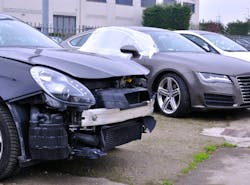In a previous column, I discussed how to determine the “sweet spot” for your shop in terms of work in progress (WIP): The range in car count you want onsite to maximize your shop’s throughput, touch-time, cycle time, and profitability. The goal is to minimize the number of jobs onsite that are not being worked on while always having another job ready to move into production as soon as there’s a stall, and a technician ready for it, but once you’ve found the number (or range) for WIP, how do you move from where you are now to a smaller number in order to improve all those things even further?
To do that, I’d suggest measuring three categories of WIP.
1. Active WIP
This includes the vehicles in stalls with technicians working on them, work orders that are next in the queue, and vehicles ready to move into production, with all parts and insurance approvals in hand. You can think about this WIP a little bit like milk in a grocery store. A store always wants milk on hand for its customers, but it doesn’t want to order too much and have unsold cartons reach the expiration date. You always want a job ready to go when a technician can start it while minimizing the number of jobs sitting around untouched.
2. Inactive WIP
This is work you cannot move into production because you’re waiting for parts or an insurer approval. Some inactive WIP may be beyond your direct control. I recently had a shop owner tell me his shop was on its third week waiting for an insurer approval.
If a non-drivable car is towed into your shop, and some of the parts needed are on national backorder, that’s inactive WIP you can do little about. Occasionally, a job may move from active WIP to inactive or vice versa. If a job gets delayed because a needed sublet vendor gets backed up or takes longer than expected to perform a task, that vehicle may move from active to inactive WIP.
3. Self-inflicted inactive WIP
This is inactive WIP that could be avoided with the right processes in place.
For example, you write a quick estimate on a job, order the parts needed based on that estimate, and have the customer bring the car in a few days later. If it’s only then you fully disassemble the vehicle and discover that more parts are needed, that job moves into the self-inflicted inactive WIP column. This WIP could have been avoided.
Let’s say you fully disassembled the vehicle, wrote a complete estimate, ordered all the parts, and checked them in. At the time of reassembly, you discovered you have a “left side” part in a box marked “right side,” but because you didn’t mirror-match it to the damaged part, you didn’t know. That’s self-inflicted inactive WIP while you wait for the correct part.
If you don’t have good processes to avoid this type of thing, that results in more WIP within your shop than is necessary, which pulls down your performance numbers. You can ask why until you find the root cause, and then you can build processes to reduce it. This might mean researching the OEM procedures, writing more complete repair plans, managing the parts process, and effectively communicating with all the stakeholders (technicians, vendors, insurers, and customers).
It might be helpful to measure how much of the three types of WIP you have in front of various process centers, and how much you have within your paint department, body department, or blueprinting department. The “low-hanging fruit” to address will be any self-inflicted inactive WIP, such as when staff bring in too many ready-to-work-on jobs on a Monday. In any case, I would love to get your feedback by email on what ratio of active to inactive WIP seems best for your business.
As you begin to refine and reduce the amount of WIP in your shop, your performance numbers will improve, but you’ll also need good systems to ensure you consistently maintain that narrower band of WIP you need. I’ll talk about those systems in a future column.
About the Author
David McCreight
president
David McCreight, LSSBB, president of Collision Resources, has more than two decades of experience helping body shops grow and improve through business coaching, software solutions, and marketing and management services.

